Jews in the Soviet Union up to 1940
(Part 3 of 3)
Jewish Life Between the Wars
The Yevsektsii, the Jewish sections of the Communist Party, are the main instrument of the new government in applying the Marxist doctrine of forced assimilation.
The majority of Russian Jews support the various Zionist organizations; these become the first to be liquidated. Zionism is labeled "a bourgeois-clerical tendency," and thousands of Zionists are exiled to Siberia.
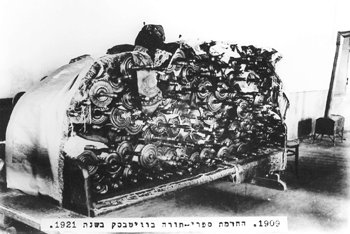
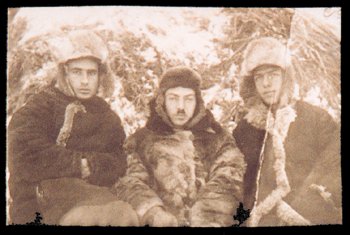
At your left, Torah scrolls piled up for destruction in the Vitebsk synagogue, one of the estimated 650 synagogues that were closed in the 1920s. Also in Vitebsk, a show trial was held against the kheyder, the traditional Jewish school, resulting in its immediate closure.
At your right, N. Edelberg, S. Isazro and L. Beigman, members of the Zionist Socialist Party, in exile in the Ural, ca. 1927.
The systematic attack of the Bolshevik government upon all organized religions also affects Judaism. The Yevsektsii close down synagogues and kheyders, confiscate religious books and objects, and conduct a campaign against rabbis, ritual slaughterers and other essential functionaries of Jewish religious and communal life. If they refuse to resign, they are arrested and deported.
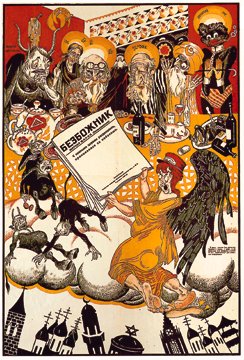
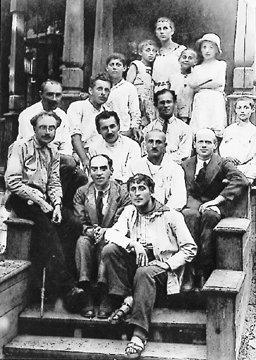
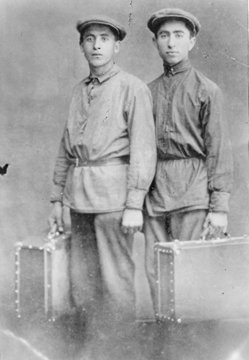
At your left, Judaism is
one of the religions attacked in this poster from 1922 for the magazine Bezjbozjnik
(The Atheist). By 1934, 28 percent of the Orthodox churches, 42 percent of the
mosques, and 52 percent of the synagogues in the Soviet Union had been closed
down.
In the middle, The painter
Marc Chagal (front) with teachers and children at the Malakhovka children's
colony near Moscow in 1923. Chagal settled in Paris in the same year. Behind
Chagal sits the Yiddish writer Der Nister, one of many who had returned to the
Soviet Union to participate in Yiddish cultural life. He became a victim of
the campaign against "Cosmopolitans" in 1952.
At your right, before setting
off to the city to work in industry, two young Jews have their photos taken.
The Yevsektsii also campaign against the Hebrew language. In their eyes, Hebrew is the reactionary language of the Jewish bourgeoisie, whatever its content, and has to be eliminated in favor of Yiddish, the language of the Jewish proletariat. Hebrew schools and printing presses are closed.
At the end of the 1920s, Hebrew becomes the only language which is officially outlawed in the Soviet Union. Jewish religious education is now impossible. The only permitted expressions of Soviet-Jewish life are secular Yiddish education, literature, press and theater. They flourish as long as they are permitted, until the mid 1930s.
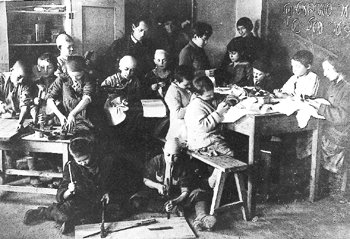
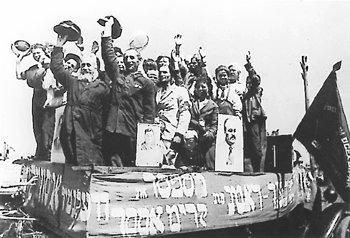
At your left,
an Yiddish school in Kharkov, Ukraine, in 1922. The banner reads: "Children's
home - the home of Communist culture." As the schools were Yiddish in language
only, and Judaism the target of the anti-religious curriculum, the number of
pupils diminished rapidly.
At your right,
Collective farmers from the Frayveg (Free Way) kolkhoz in Larindorf, Crimea,
on their way to an election meeting in 1938. Collective farms in the Crimea
attracted more Jewish settlers than Birobidzhan, but plans to settle Jews in
the Crimea were stopped after protests from the local population.
The newly established Yiddish schools are very popular at first. But as only few secondary school and no university courses are in Yiddish, their numbers decline. At the end of the 1930s, they have completely disappeared.
With the almost complete elimination of organized Jewish religious and communal life, the Yevsektsii have become redundant and are dissolved in 1930. During the Stalinist purges of the late 1930s, most of its members are accused of having had "nationalist tendencies," and are deported or killed.

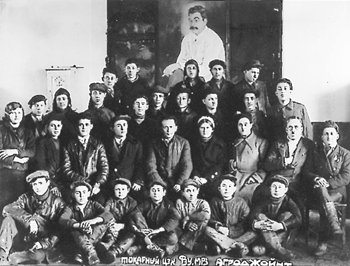
At your left,
graduates and teachers of the Yiddish Professional Technical School in Cherkassy,
Ukraine, in 1929.
At your right,
group of students in an Agro-Joint workshop being trained as metal workers.
Through the Agro-Joint, the American Joint Distribution Committee gave aid to
colonization schemes in order to relieve Jewish poverty. The Agro-Joint was
liquidated in October 1937.
The economic life of the shtetl lies in ruins after the successive disasters of the First World War, the Civil War and the years of "War Communism." The New Economic Policy of 1921 brings some relief as farmers and artisans are once more allowed to trade their own products, but this policy is reversed with the introduction of the first Five Year Plan in 1928.
The following rapid industrialization and collectivization completely destroy the socio-economic fabric of shtetl life. Traditional Jewish occupations like shopkeepers, artisans and traders disappear, and tens of thousands of Jews have to leave their homes to work in the new industries. Because of their relatively high level of education, many Jews find employment in government services or work as doctors, engineers, managers, accountants etc. In order to promote agricultural work among Jews, and to offer a Soviet alternative to Zionism, the government establishes a Jewish Autonomous Region in the far-eastern region of Birobidzhan.

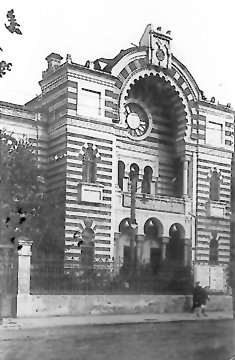
At your left,
poster from the campaign against the intensifying anti-Semitism at the end of
the 1920s. This was the only campaign of its kind in the Soviet Union.
At your right,
the Synagogue of Minsk turned into the Jewish State Theater in 1934. In Minsk
and Odessa, some people were killed when the military closed the synagogues
by force.
But the plan is a failure. The climate is extremely harsh, and the region is too far from the major centers of Jewish life. The Jewish population of Birobidzhan reaches its peak with 24 percent in 1937.
The massive migration of Jews out of Belorussia and the Ukraine, and the radical change in their occupational structure, result in a rapid assimilation into Soviet society. Yiddish is more and more replaced by Russian, and the number of mixed marriages rises to almost a third in the 1930s. In the lifetime of one generation, the Russian Jewish community has undergone fundamental change.